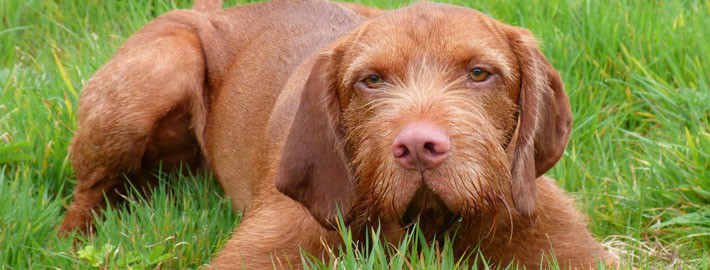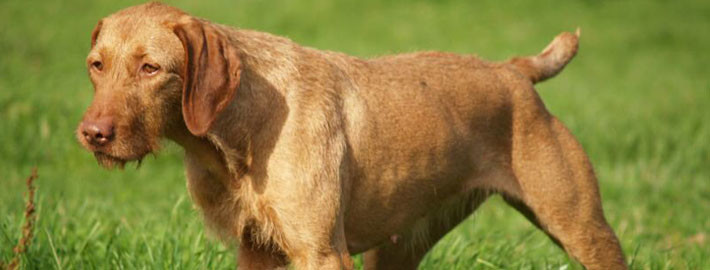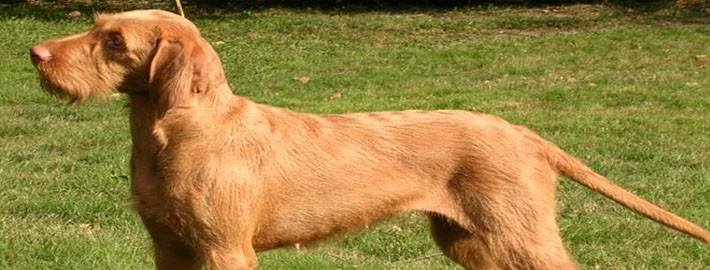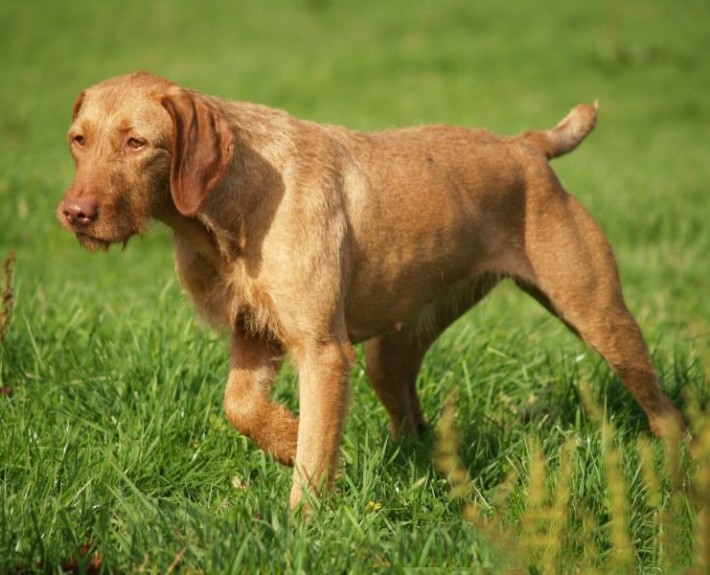What makes the Wirehaired Vizsla Unique?
The Wirehaired Vizsla is a versatile, medium-sized hunting dog that possesses an excellent nose for hunting and tracking, as well as a natural point and retrieve. Although similar to the more common smooth-coated Vizsla in many ways, the WHV is a distinctly separate breed. The most obvious difference is its 1-2 inch long dense wiry coat, which is golden rust in color to help the dogs blend into dried grasses and brush in the field.
Breed Groups
- Hunting Dog Breed
- Medium Size
Page Contents
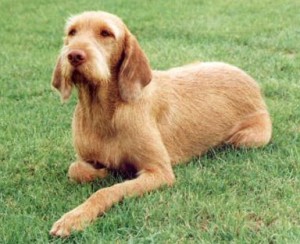
SnapShot
Is the Wirehaired Vizsla Right For You?
Gentle, outgoing and friendly, Wirehaired Vizslas make loyal family companions. They are intelligent and trainable for hunting as well as other sports such as agility and obedience. Due to the athletic nature of the WHV, regular exercise is a necessity. The breed’s wiry coat should be kept in its natural state, with occasional brushing, bathing and stripping to tidy up furnishings.
In 5 Words
- Alert
- Hunter
- Companion
- Watchdog
- Courgeuos
Characteristics
Learn More About Wirehaired Vizsla
Description
The head of the Wirehaired Vizsla is lean and noble. The skull is moderately wide between ears with a median line down the forehead and a moderate stop. The skull is a little longer than muzzle. Muzzle, although tapering, is well squared at the end. The nostrils are well developed, broad and wide. Jaws are strong and powerful. Lips cover jaws completely and are neither loose nor pendulous. The color of the nose is brown. Eyes are neither deep nor prominent, of medium size and are a shade darker in color than coat. Slightly oval in shape, eyelids fitting tightly. Yellow or black eyes are undesirable. Ears are moderately low set, proportionately long with a thin skin and hanging down close to cheeks. Rounded “V” shape, not fleshy. The mouth is sound and has strong white teeth. Jaws are strong with perfect, regular and complete scissor bite, i.e. upper teeth closely overlapping lower teeth and set square to the jaws. Full dentition desirable. The neck is strong, smooth and muscular, moderately long, arched and devoid of dewlap. The shoulders are well laid and muscular, elbows close to body and straight, forearm long, pasterns upright. The back level is short, well-muscled, withers high. Chest is moderately broad and deep with prominent breast bone. Distance from withers to lowest part of chest equal to distance from chest to ground. Ribs are well sprung and belly has a slight tuck-up beneath loin. Croup is well muscled. Hindquarters are straight when viewed from rear, thighs well developed with moderate angulation, hocks well let down. The feet are round with toes short, arched and tight. Cat-like foot is required, hare foot undesirable. Nails short, strong and a shade darker in color than coat, dewclaws should be removed. The gait/movement is graceful, elegant with a lively trot and ground covering gallop. The tail is moderately thick, rather low set, customarily one-third docked. When moving, carried horizontally. Hair on head short and harsh, longer on muzzle, forming beard. Pronounced eyebrows. Longer and finer on ears. Longer over body, fitting closely to neck and trunk. Short harsh hair fitting closely and smoothly to forelimbs. Coat color is russet gold. Small white marks on chest and feet should not be penalized.
Short History of the Wirehaired Vizsla
The Hungarian Wirehaired Vizsla was created by cross-breeding the Hungarian Short-Haired Vizsla with a German Wirehaired Pointer in the 1930s. His breed characteristics are identical to those of the Hungarian Short-Haired Vizsla.
Temperament
An affetionate and intelligent dog, self-confident, easily trained, which cannot bear rough treatment. He keeps contact with his handler, is passionate in his quest, is stubborn, has a good nose and is staunch on the point.
Caring for Your Wirehaired Vizsla
General Health
The Wirehaired Vizsla is generally considered to be a healthy breed, in part because of the hybrid vigor associated with the outcrossing of several different breeds so recently in its history. They have a fairly long life expectancy, averaging 12 to 15 years. Reported health concerns in this breed, although not necessarily common or hereditary, may include Addison’s Disease (hyperadrenocorticism), Cushing’s Disease (hypoadrenocorticism), hypothyroidism, autoimmune hemolytic anemia, cancer, inflammatory bowel disease, hip dysplasia, elbow dysplasia, metabolic muscle disease, canine stress syndrome/malignant hyperthermia, epilepsy, sebaceous adenitis, atopy (allergies), ear infections (otitis), reproductive disorders (infertility), progressive retinal atrophy (PRA), corneal dystrophy and juvenile/developmental cataracts.
Grooming & Bathing
Wirehaired Vizslas do not require much maintenance, so they are perfect for dog owners who have little time or money to spend on grooming. Their nails do need to stay trimmed, and they should be brushed occasionally. They shed some but not as much as many other breeds.
Exercise & Training
Exercise is a daily requirement for this energetic hunter. At least an hour a day of exertion is recommended, and the ideal situation would combine exercise with hunting or a chance to run and explore afield. As a breed that thrives on human companionship, it does best as a house dog with access to the outdoors. Like most harsh coats, some minimal hand-stripping may occasionally be needed to maintain a sleek outline; otherwise, brushing about once a week will suffice.

